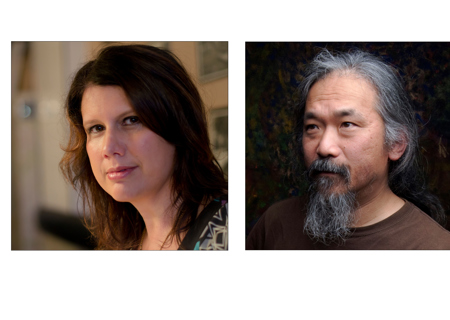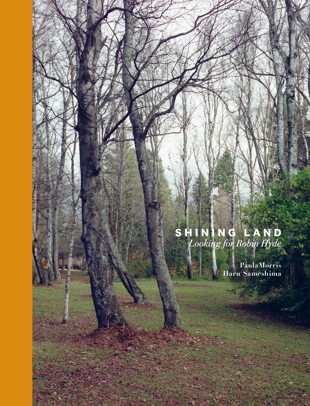Q1: The kaupapa behind the kōrero series is a writer and an artist in collaboration, creating a ‘picture book for grownups’. When series editor Lloyd Jones approached you both, was the idea immediately appealing?
PM: I rely on visual material a lot when I'm working on a book, and incorporated photographs into False River, my 2017 collection of stories and essays, so the idea of a collaboration with an artist was exciting. It offered so many possibilities for imaginative collusion and points of departure.
HS: Absolutely — a dream project for a photographer. I welcomed the format — equal weight for writer / visual artist contributions, rather than one illustrating the other. Too often, either the image illustrates the writing, or writers go writing about images. When Lloyd Jones, the kōrero series editor, proposed this framework, I knew instantly this was different — two art forms and artists acting independently, but empathically, on a topic. Having grown up in the Japanese graphic-novel culture, I knew I was in a good place with the idea of a ‘picture book for grownups’.
Q2: How much about Hyde did you each know when you set out on the project, and how did you share what you were discovering?
PM: I knew a reasonable amount about her life, and had read a few of her books, but I had preconceptions, too, of Hyde as a sort of madwoman in the attic. She was much more complex, ambitious and brave a person than I'd realised. This project demanded that both Haru and I become Hyde obsessives. We had long conversations in the manner of know-it-all fans who find the topic endlessly fascinating. We both like disappearing down rabbit holes, it seems, and digging around. I think at one point Haru almost bought the kind of typewriter Hyde used in the 1930s.
HS: I knew very little about her — only by name, and some distant memories from school. Paula gave me a succinct chronology and outline around her own interest and obsessions with Robin Hyde’s stories. I read The Godwits Fly, and Check to Your King first as preliminary research. I was particularly interested in the novel about Baron De Thierry because I had come across him through my interest and travels in the Hokianga and Bay of Islands following the 19th century trails of Augustus Earle in another project. I quickly became aware of the passion and in-depth scholarship that existed in this somewhat overlooked writer, in particular the writing by her son Derek Challis in The Book of Iris: a life of Robin Hyde. Then there was Mary Edmond-Paul, and Michelle Leggott. Their books, Your Unselfish Kindness: Robin Hyde’s autobiographical writings, and Young Knowledge: the poems of Robin Hyde, became my travel guide books.
Q3: You each individually went on road trips to places in which Hyde had spent time in. How important was that?
PM: Road trips are at the heart of this book, and we always planned to go separately, so we could engage with the places on our own then report back with words and pictures, and different perspectives. They were trips to places and trips into the past, often with frustrating dead ends. I like the way searching for lost things slows down the process of thinking as well as writing, and the sensory immersion of being in a particular place. Plus meeting people and uncovering local knowledge and memories.
HS: As a photographer, the road trip was a necessity for the way the project unfolded around specific places and buildings. These were places of significance in Hyde’s life. As Paula explored Hyde’s and her own biographies, I independently read into Hyde's biographies and Paula’s developing text. I wanted to extend my trip to include the South Island as I spent a significant time of my life there and many of the places Hyde ended up, or mentions in her works, were familiar to me. As a journalist, Hyde travelled extensively around New Zealand, and some of these places crossed over with my own travels as a roving photographer.
Q4: Is hers a tragic life or a remarkable life?
PM: Both. What she managed to achieve in such a short life is incredible, especially given the obstacles she faced as a young woman building a career and trying to support her son. It would be hard now, without having to keep so many secrets and manage a double life.
HS: It is difficult to measure historic figures in these terms. Without the immersive research done by those earlier scholars to illuminate her life I would not have gleaned as much, but she achieved a remarkable amount of output as a writer and lived a remarkable life full of vigour. The tragedy being the life was so short and we have been robbed of what might have been possible had she lived to her maturity.
Q5: How important a literary figure is she in this country?
PM: Hyde is an important figure in many aspects of 20th century writing in New Zealand — poetry, fiction, journalism, war reporting, nonfiction. Her roman a clef, The Godwits Fly, is a groundbreaking classic, and her visceral recreation of World War I in Passport to Hell makes it essential testimony. Her own gripping testimony of Japan’s invasion of China, in Dragon Rampant, should be read much more widely.
HS: I am no literary expert so, for me, it’s impossible to evaluate. Personally, I admire the diversity in her literary output — from newspaper columns and parliamentary reports to biographical and historical novels and poetry plus groundbreaking war journalism, letters and poetry. Her journalism is urgent, witty and observant and displays remarkable insights into local society, in particular race relations and regional history. This, coupled with her interest in historical narratives of 19th century settlers and war veterans, makes her an extraordinarily flexible and talented writer, successful in a multitude of publishing arenas and for diverse audiences. I think the mixed reviews by her contemporary literary figures that Paula quotes in our book are due to the narrowness of this small society in which an artist was supposed to be only good at one thing. From today’s perspectives, Robin Hyde’s literary output is a remarkably rich source of discourse, and there is ongoing interest in her work from a far wider range of readers and critical assessments.
Q6: What shocked you about her life?
PM: How hard it was for a young, intelligent woman in New Zealand to make a living and have an independent life in the 1920s and 1930s. How she had to lie to her family and lie to employers about her pregnancies, and how much resilience she needed to counter the shame (about having sexual relationships, about living in an asylum’s halfway house) heaped on her.
HS: The extent to which out-of-wedlock pregnancy was reviled in society, to the point that Hyde had to exile herself to a remote corner of this country like D’Urville Island. That plus the far-reaching effects of the World Wars that sandwiched her short life span.
Q7: What were you surprised to learn?
PM: The importance of war in every aspect of her life and work. World War I altered or corrupted many of the key men in her life — family, colleagues, lovers, book subjects — and she came of age in its vast shadow. Her own traumatic experience of war, on the frontline in China, gave her PTSD, I believe.
HS: The public hospital system of the 1920s and 1930s in New Zealand. Hyde’s experiences with the ‘mental’ hospitals of the time were remarkably positive, unlike the common perception of the asylums as lock-up wards complete with loss of agency, aggressive treatment and suppression of individuality, often associated with the experiences of writers like Virginia Woolf and Janet Frame. While Hyde feared the worst, when she was a whisker away from being committed to the notorious Porirua Mental Hospital, her actual experience at the Queen Mary Hospital’s newly opened women’s ward (later called Chisholm Ward) in 1927 was regenerative, effectively restoring her after a five-month stay to launch into a new spurt of creativity. Similarly in 1933, her voluntary admission to ‘The Lodge’, the extramural ward at Auckland Mental Hospital at Avondale, was to last for four years, during which time she completed and worked on many of her major literary works in the special attic she was assigned. It was as if the hospital offered an artist’s residency and she had a safe place to concentrate on her creative work.
Q8: You both worked on this project before, during and just after lockdown. What pressure did those level-four weeks exert?
PM: I was racing to finish my road trips before lockdown. We moved to Level 3 when my husband and I were still up north at Whangaroa Harbour, the last guests at the motel before it closed. The move to Level 4 was announced on our drive back. Then I lived in lockdown with Robin Hyde, basically. It was intense.
HS: Just before the lockdown Paula and I were able to meet up a couple of times, to discuss our approaches and visit ‘The Lodge’ together. Level-four lockdown was like my artist’s residency: I was able to read as much of the Hyde material as time allowed and plan my trip. This is when I decided to extend my trip to the South Island. As soon as Level 2 kicked in I left in a car for the three weeks’ travels, zigzagging through the North and South Islands, finishing up in Hanmer Springs to photograph the Chisholm Ward. So apart from extending the deadline a little longer, lockdown totally worked in my favour for this project.
Q9: I get the feeling that neither of you is quite done with Hyde yet. What has working on Shining Land inspired you to do?
PM: I don't know if Haru is still keen, but I want the two of us to go to China at some point and recreate Hyde’s unbelievable odyssey to the heart of a brutal war (and her escape). Also, I would love to see an edition of her letters.
HS: I have so much more material from most of the locations than what ended up in the book, and I am interested in other places Hyde visited for three months in the South Island in 1936, when she was invited to visit Dunedin to do research at Hocken Library and she made a circular tour of the South Island. Her account of the Japanese invasion in China during 1938, published as Dragon Rampant, could be eye-opening material for a photographic follow-up. I realise such a project will be a logistic and artistic quagmire, but Paula mentioned her interest in visiting China later, if travel offshore ever happens again, it would be great to explore the China chapter together. I would like to read more of Hyde’s journalistic works, in Journalese and Disputed Ground, to find more overlaps with my travels in New Zealand.
Q10: What do you hope readers will take away from reading Shining Land?
PM: A desire to read more of Hyde’s work. Perhaps more of an understanding of the pressures and hypocrisies of that between-the-wars era in New Zealand, and how the first war ravaged a generation. Also, I hope readers will be in awe of Haru’s photography, and his eye for secret places and strange details, as well as astounding landscapes.
HS: If some of the photographic descriptions of the locations associated with Robin Hyde, combined with Paula’s fresh and incisive take on her life in this book, contributes to the existing Hyde scholarship in a small way, and feeds the interest and appreciation of Iris Wilkinson’s works with a new audience, I’d be pleased.


